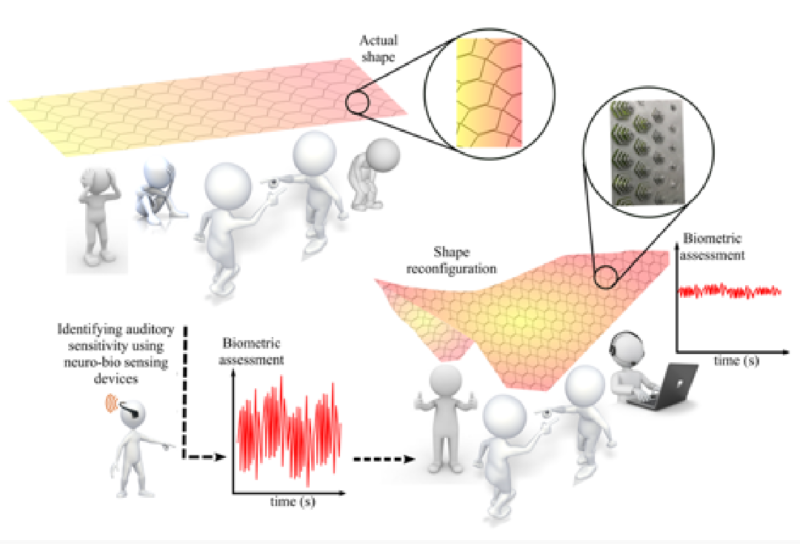Adverse conditions of the built environment can significantly affect and even compromise multiple facets of human behavior, such as comfort, productivity, and engagement. We envision an intelligent space with the ability to continuously and unobtrusively sense each individual’s physical, cognitive, and emotional state, and reconfigure the corresponding environmental conditions (i.e., sound, light and heat) to achieve a comfortable personalized space. This intelligent space will elevate and improve occupants’ daily life, which is crucial for promoting physical and emotional well-being.
One important field that will benefit from this intelligent space is healthcare. In this proposal, we will focus specifically on addressing the need of children with autism spectrum disorder (ASD). Regular everyday-life stimuli, such as noise, scent, light, and heat, can feel like a continuous bombardment for many children with ASD. Children with ASD have difficulties in filtering relevant sensational information, e.g., between paying attention to a teacher speaking in class, bird whistling outside the classroom, or traffic noise from the street, compromising a significant impediment to learning outcomes. Sensory abnormalities defined as hyper (or hypo) sensitivity to changes in environment–occur in 69% to 93% of children with ASD. Coupled with difficulties in communication, sensory abnormalities can frequently result in challenging behaviors (e.g., aggression, tantrums) and difficulty with attention, hence negatively impacting individuals with ASD and their families in terms of quality of life.
Among all sensory abnormalities that have been reported in available studies, auditory sensitivity is hypothesized as the most prevalent and associated with communication deficiency and learning difficulties. Currently, a common approach to promote learning for children with ASD is to isolate them in a sensory friendly room (sensory stimulation or sensory deprivation area). This isolation affects negatively on their social behaviors. In uncontrolled environments, ear plugs or headphones are used to minimize the adverse effect on children suffering with auditory abnormalities, which can cause long-term discomfort.
Adverse conditions of the built environment can significantly affect and even compromise multiple facets of human behavior, such as comfort, productivity, and engagement. We envision an intelligent space with the ability to continuously and unobtrusively sense each individual’s physical, cognitive, and emotional state, and reconfigure the corresponding environmental conditions (i.e., sound, light and heat) to achieve a comfortable personalized space. This intelligent space will elevate and improve occupants’ daily life, which is crucial for promoting physical and emotional well-being.
One important field that will benefit from this intelligent space is healthcare. In this proposal, we will focus specifically on addressing the need of children with autism spectrum disorder (ASD). Regular everyday-life stimuli, such as noise, scent, light, and heat, can feel like a continuous bombardment for many children with ASD. Children with ASD have difficulties in filtering relevant sensational information, e.g., between paying attention to a teacher speaking in class, bird whistling outside the classroom, or traffic noise from the street, compromising a significant impediment to learning outcomes. Sensory abnormalities defined as hyper (or hypo) sensitivity to changes in environment–occur in 69% to 93% of children with ASD. Coupled with difficulties in communication, sensory abnormalities can frequently result in challenging behaviors (e.g., aggression, tantrums) and difficulty with attention, hence negatively impacting individuals with ASD and their families in terms of quality of life.
Among all sensory abnormalities that have been reported in available studies, auditory sensitivity is hypothesized as the most prevalent and associated with communication deficiency and learning difficulties. Currently, a common approach to promote learning for children with ASD is to isolate them in a sensory friendly room (sensory stimulation or sensory deprivation area). This isolation affects negatively on their social behaviors. In uncontrolled environments, ear plugs or headphones are used to minimize the adverse effect on children suffering with auditory abnormalities, which can cause long-term discomfort.
The proposed project integrates and aims to advance knowledge in adaptive structures and personalized room acoustic environments, artificial intelligence, and behavioral interventions. Fundamental research accomplishments will arise from: 1) characterizing tunable acoustic properties using adaptive structures; 2) a paradigm shift in personalizing auditory environments as opposed to the currently homogenized and centralized environments, 3) a deeper understanding of causes and expressions of auditory stimuli for children with ASD, 4) novel specific machine learning models that learn and integrate the inherent inter-individual variability for improving predictions of human outcomes, and 5) novel computational models for determining the optimal conditions of the built environment based on an individual’s neuro-physiological state.
The successful completion of this study will promote the well-being and quality of life of children with ASD and their families, and augment interventions at any stage, and particularly in early childhood. Beyond ASD, the perception of environments is inherently diverse among occupants and varies over time. Thus, personalized responsive auditory environments can be extended to include other stimuli, such as light and thermal, and can be placed in public buildings, such as offices and hospitals. Personalized environments will not only improve comfort levels of building occupants, which can yield positive health outcomes and augment performance of a diverse set of building occupants, but also improve the efficiency in energy consumption. Once we successfully develop the acoustic intelligent and adaptive space, it can be integrated in a portable and mobile platform for serving children with ASD in underserved areas, including but not limited to rural, impoverished, and broader communities.
